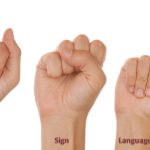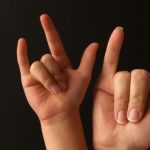
ASL and BSL: How Different Are They?
ASL and BSL serve one and the same purpose: They are a means of communication for the hearing impaired community. But the similarities end right there.
The two sign languages developed independently of each other. Apart from a few similar signs, the lexicon is vastly different in both languages. To put it in a nutshell, one cannot compensate the other and they are mutually incomprehensible too.
Let’s explore the two sign language types and bring out some stats to support the claim:
- ASL has a one hand alphabet and BSL has a two hand alphabet.
- In ASL, the extended middle finger is almost never used to form a sign. In BSL, the middle finger is used neutrally to denote some signs like “holiday”.
- The American deaf community engages in a great deal of finger spelling. Their British contemporaries tend to use classifiers rather than finger spelling.
- The ASL is a complete, sophisticated form of communication that uses more body language and facial expressions.
- The BSL is also a complete and distinguishable language that does not use as much body language as ASL.
- ASL’s one-hand finger spelling was developed by medieval French Belgian clergy.
- BSL’s two-hand finger spelling was devised by Father Bede of Harrow who was also known as the Father of Education.
Key Features of the American Sign Language

Here’s a compilation of all that you need to know about the American Sign Language or ASL:
- ASL is most commonly used by the deaf community in the United States and Canada.
- ASL is the third most-commonly used language after English and Spanish.
- ASL is a language by itself and it does not, in any way, represent the English language that is commonly used by other people.
- ASL is a visual gestural language that uses gestures of the fingers and body language.
- ASL is strongly connected to the French Sign Language as it was originally developed by members of the French Belgian clergy.
- A person using ASL would not be able to understand BSL or the Australian Sign Language AUSLAN.
Key Features Of The British Sign Language
- BSL is the language of more than 145,000 people within the UK.
- The language has its own grammatical structure and syntax.
- It is not dependent or strongly related to the normal English language.
- BSL is easily understood by those in Northern Ireland, not by those in Scotland because the sign language is different there.
- BSL is a part of BANZSL which is a compilation of British, New Zealand and Australian sign languages.
- There are considerable variations of the sign language used within Britain.
- ASL and BSL share only 30% of the signs, which make them distinct to each other.
ASL and BSL: Which Is The Better Choice?
While the choice of sign language is entirely up to the person, there is one universal rule of thumb: take into account the sign language that is in most use in the area or country you live in.
It is also important to know if the local sign language has connection to other sign languages. This will enable you to understand more than one sign language even if you learn only one. For example, Auslan or the Australian Sign Language and BSL and quite similar.
But if you live in Canada, you will benefit greatly from learning ASL. Canada has its own sign language but the differences with ASL are minor.
So, it is a clear conclusion that the hearing impaired communities in the respective regions benefit largely from the respective sign languages. Communication matters and that’s what’s important.
ASL and BSL have their own distinguishable features. Hence, where one will use the language is what really matters when one is making the choice.
Click To Know More About : The Various Sign Language Types Used Across The Globe











